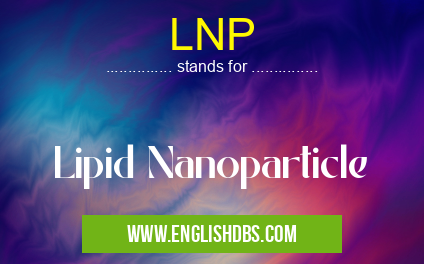What does LNP mean in BIOLOGY
Lipid Nanoparticles (LNPs) are small, fat-based particles used to deliver molecules such as small interfering RNA (siRNA), microRNA, or messenger RNA (mRNA) into cells. LNPs provide a versatile method for delivering therapeutic agents to particular targets in the body with little or no toxicity. This technology has been used in clinical trials and is quickly becoming a preferred delivery option for numerous treatments.

LNP meaning in Biology in Academic & Science
LNP mostly used in an acronym Biology in Category Academic & Science that means Lipid Nanoparticle
Shorthand: LNP,
Full Form: Lipid Nanoparticle
For more information of "Lipid Nanoparticle", see the section below.
What Does LNP Stand For
LNP stands for Lipid Nanoparticle. It is an engineered nanoparticle composed of lipids, which are fats and related compounds that make up cell membranes and act as a barrier between the inside and outside of cells. The lipid layer also helps stabilize the particles so they can be used in biological systems without breaking down or clumping together.
What is Lipid Nanoparticle Technology in Science?
Lipid nanoparticle technology is a new form of drug delivery system developed to improve the efficacy of drugs by increasing their absorption rate while reducing their side effects. This technology uses tiny particles made out of lipids, which allow drugs to move through cellular and tissue barriers more easily than other methods. These particles are also better tolerated by the body than traditional methods of drug delivery, making them ideal for use in pharmaceuticals and medical research.
Benefits of Using LNP
Using LNPs has several benefits over traditional drug delivery mechanisms such as injection, oral administration, or topical application. First, these particles are very small, allowing them to easily pass through cellular barriers, thus allowing larger molecules to be delivered directly to target tissues or cells in the body with improved accuracy over traditional methods. Additionally, since these particles are composed mainly of lipids instead of other materials such as polymers or peptides, they tend to be better tolerated by the body than other forms of drug delivery systems and show fewer side-effects when compared to other technologies. Finally, this technology allows drugs to be delivered directly into cells without causing any disruption in cell function due to its high biocompatibility.
Essential Questions and Answers on Lipid Nanoparticle in "SCIENCE»BIOLOGY"
What is a Lipid Nanoparticle?
Lipid Nanoparticles (LNPs) are nanoparticles that are composed of lipids (biocompatible fatty molecules). LNPs can transport genetic material such as DNA, RNA, or gene therapies, as well as other drugs and small molecules. These particles are biocompatible and can be used to lipidize and protect molecules for easy delivery into cells.
How do Lipid Nanoparticles work?
Lipid Nanoparticles have several components that allow them to bind with their target molecules for efficient delivery. The nanoparticle contains an inner core of lipids that acts like a shield, encapsulating the target molecule. This makes the particle more stable in order to reduce the chances of exposure to external factors. Additionally, these particles contain an outer shell which consists of one or more polymers such as polyethylene glycol or polyacrylic acid for improved adhesion to cells.
What benefits do Lipid Nanoparticles provide?
Lipid nanparticles offer several advantages over traditional delivery methods including improved safety, better control of bioavailability, enhanced targeting and uptake by cells, increased stability within the body, reduced toxicity and immune response, and increased storage capabilities. Furthermore, they are highly customizable allowing precise control over drug formulation and loading capacity.
Are there any potential risks associated with Lipid Nanoparticle use?
While LNPs are generally safe compared to other drug delivery mechanisms, there are some risks associated with their use as certain components in the particle may cause adverse side effects such as irritation or inflammation at targeted sites. However, laboratory studies have demonstrated that properly formulated LNP particles have low toxicity levels and show no significant immunogenicity or genotoxicity effects when administered in vivo.
Is it possible to customize Lipid Nanoparticle formulations?
Yes! The structure and composition of LNP particles can be tailored for specific applications due to their modular nature allowing researchers to alter the size range, surface features, charge state distributions and other characteristics which will improve performance in a given system. Additionally the core lipid content can also be modified depending upon desired properties such as physical stability or biodegradability.
Does Lipid Nano Particle technology require specialized equipment?
No! While specialized techniques may be necessary in some cases related to characterization or formulation optimization; most drug development based on this platform does not require expensive instruments or complex protocols making it a cost-effective approach for developing a wide variety of drug delivery vehicles.
Are there any limitations associated with using Lipid Nanoparticles?
There are some limitations associated with using LNP technology such as reduced efficiency due to high viscosity which needs to be overcome by either modifying composition or improving formulation process parameters specifically temperature & pressure during extrusion & encapsulation steps.. Also due availability of few approved synthetic materials limits use on certain types of applications where natural coating must be used.
Final Words:
Lipid nanotechnology is a revolutionary breakthrough in drug delivery that provides many advantages over traditional routes such as injection or oral administration. It simplifies complex drug molecules down into smaller sizes and incorporates them into lipidic nanoparticles which can easily pass through cellular barriers but remain stable enough on their own not too breakdown or clump together once inside the body’s cells while causing minimal disruption during transport or release process within cells which makes it highly useful for biomedical research purposes especially when used alongside gene therapies like mRNA vaccines that have become so important throughout this Covid-19 pandemic era.
LNP also stands for: |
|
| All stands for LNP |
